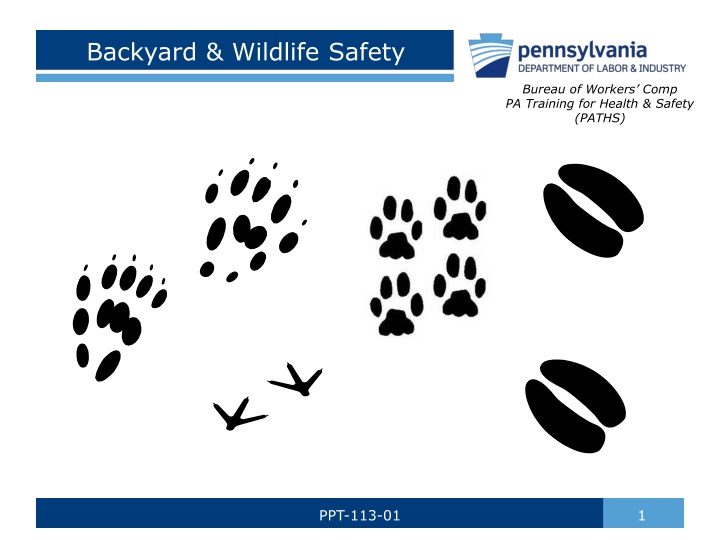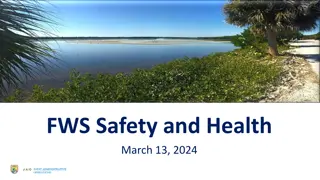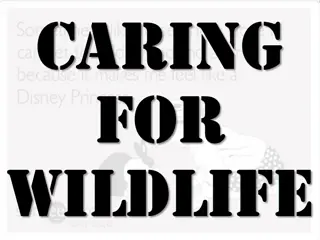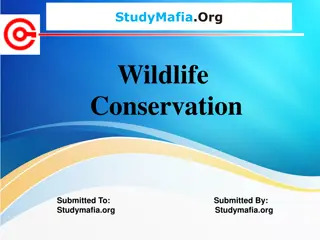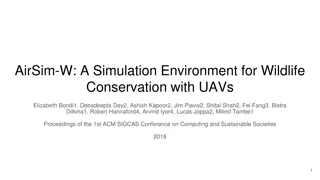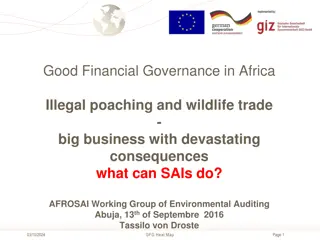Backyard & Wildlife Safety
Essential information on recognizing and handling backyard wildlife to ensure safety. Topics include potential harms, reasons for wildlife presence, and risks of diseases like rabies and Lyme disease. Learn about identifying common backyard wildlife and minimizing risks for a safe and sustainable environment.
Download Presentation

Please find below an Image/Link to download the presentation.
The content on the website is provided AS IS for your information and personal use only. It may not be sold, licensed, or shared on other websites without obtaining consent from the author.If you encounter any issues during the download, it is possible that the publisher has removed the file from their server.
You are allowed to download the files provided on this website for personal or commercial use, subject to the condition that they are used lawfully. All files are the property of their respective owners.
The content on the website is provided AS IS for your information and personal use only. It may not be sold, licensed, or shared on other websites without obtaining consent from the author.
E N D
Presentation Transcript
Backyard & Wildlife Safety Bureau of Workers Comp PA Training for Health & Safety (PATHS) PPT-113-01 1
Objectives To understand wildlife and how to cohabitate in that environment safely. Be able to recognize and identify backyard wildlife to avoid and be better able to cohabitate with. PPT-113-01 2
Wildlife 1. Spiders 7. Rabbits 2. Stinging pests 8. Squirrels 3. Skunks 9. Fleas 4. Ground hogs 10. Cats 5. Deer 11. Dogs 6. Bats 12. Snakes PPT-113-01 3
What harm can they be? Potential of injuries, disease & parasites to humans Rabies Fleas Bites Stings Strains and sprains Broken bones Anaphylactic reactions PPT-113-01 4
Why do they like my yard? Food Shelter Bird feeders Grass, grubs Fruit bearing plants Gardens Trash Sheds Crawl spaces Decks Safety From traditional predators PPT-113-01 5
Rabies A disease virus which enters through a bite from an infected animal and causes brain swelling If not treated quickly results in convulsions, respiratory failure and DEATH in every person infected Rarely infectious from saliva, aerosols, or guano. PPT-113-01 6
Rabies: Signs & Symptoms Itching or discomfort at bite site Fever Headache PPT-113-01 7
Rabies: Incubation Period 2 days to weeks = Acute phase Incubation period between phases 3 to 7 weeks (7 days to 10yrs) PPT-113-01 8
Lyme Disease Primary area Mid Atlantic, Northeast Regions including PA 12 states account for 95% of cases All 50 states reported cases (travel) Spread through bite of infected ticks Can attach to any part of body PPT-113-01 9
Lyme Disease 3 feedings daily If infected tick, transmission rate: 0% @ 24hrs 12% @ 48hrs 79% @ 72hrs 94% @ 96hrs PPT-113-01 10
Bites Dogs Cats Spiders Insects Baby wild animals Snakes Others? PPT-113-01 11
Poisonous Snakes of PA Northern Copperhead Eastern Massasauga Timber Rattle Snake Yellow phase Black phase PPT-113-01 12
Nonvenomous Snakes of PA Eastern Hognose Northern Black Racer Eastern Ribbon Eastern Smooth Earth Eastern Garter PPT-113-01 13
Nonvenomous Snakes of PA Northern Ringneck Eastern Worm Shorthead Garter Eastern Milk Eastern Rat PPT-113-01 14
Nonvenomous Snakes of PA Kirtland s Snake Mountain Earth Northern Brown Northern Redbelly Northern Water PPT-113-01 15
Nonvenomous Snakes of PA Queen Rough Green Smooth Green PPT-113-01 16
Venomous vs Nonvenomous In PA all venomous snakes have slit-like pupils, similar to a cat s eye. Nonvenomous snakes have round pupils, like humans. PPT-113-01 17
Bats Only 1% carry rabies There are over 1,100 bat species in the world only rodents have a greater number of species. Bats make up about 20% of all classified mammal species globally Approximately 70% of bats eat insects. The rest are frugivores, or fruit eaters. PPT-113-01 18
Bats Bat in the house Turn on lights Remove children and pets from the area Do not kill or damage head Attempt to locate and capture the bat If no contact with humans or pets it can be released If unknown or known contact occurred take bat for testing Same if you find a dead one in the house PPT-113-01 19
How do I know if I have them? Guano droppings exterior of house where they enter or inside locations where they reside. You see one or two at dusk or early morning flying around your house You see a lot of bats (more then 3) flying around your house or property You have a colony and need a professional assistance immediately PPT-113-01 20
Skunks Omnivore Odor is defense Life span 1-4 years Litter 2-8 Habitat: fence line, shrubs, backyards under decks or sheds Food source: vegetable matter, fruit, eggs, garbage, grubs . PPT-113-01 21
How do I know if I have skunks? Your dog inside lets you know Cone shaped dig marks in soil Sensor lights turn on randomly after dark Damaged turf They will spread disease if contact/bite with feral cats PPT-113-01 22
Getting Rid of Skunks Trapping Eliminating potential home Eliminating food source Fill or cover window wells Compost piles Treat yard for grubs PPT-113-01 23
Spiders Symptoms minor to severe Itching or rash Pain radiating from bite area Muscle pain or cramping Red or purplish color or blister Increased sweating Trouble breathing PPT-113-01 24
Spiders Symptoms minor to severe (continued) Headache Nausea / vomiting Fever / chills Anxiety or restlessness High BP PPT-113-01 25
Ankle Finders Shrews Mice family Shrub lines Ground hogs / whistle pigs Middle of nowhere sets up one day PPT-113-01 26
Groundhogs Herbivore Burrow entrance as big as basketball Dirt entrance (dirt piled up) Life span 1-5 yrs. Young look for homes in July or August Hibernator PPT-113-01 27
Contact Information Health & Safety Training Specialists 1171 South Cameron Street, Room 324 Harrisburg, PA 17104-2501 (717) 772-1635 RA-LI-BWC-PATHS@pa.gov Like us on Facebook! - https://www.facebook.com/BWCPATHS PPT-113-01 28
Questions PPT-113-01 29
